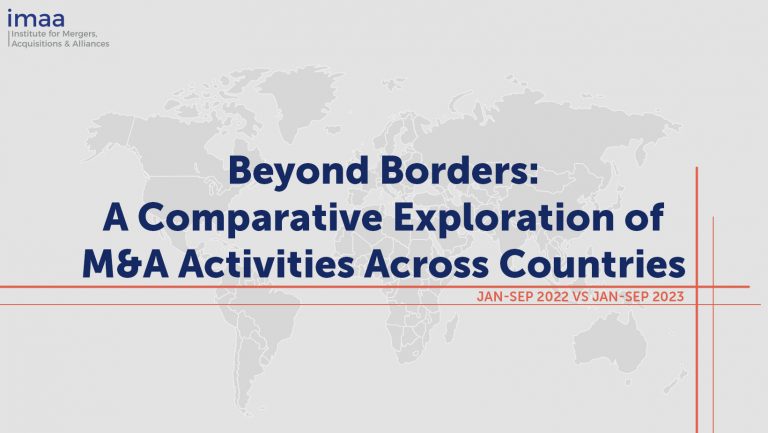
Blog Beyond Borders: A Comparative Exploration of M&A Activities Across Countries
- Blog
Beyond Borders: A Comparative Exploration of M&A Activities Across Countries
- Nima Noghrehkar

SHARE:
Mergers and Acquisitions (M&A) play an instrumental role in reshaping industries, fostering innovation, and driving corporate strategy. Over the years, M&A activities have varied across countries, influenced by various factors such as economic cycles, regulatory environment, industry trends, financial availability, global events and geopolitical factors. Here, we undertake a comparative year-to-year exploration of M&A growth across 48 countries and 3 economic groupings: BRICS (Brazil, Russia, India, China, South Africa), CIVETS (Colombia, Indonesia, Vietnam, Egypt, Turkey, South Africa), and DACH (Germany, Austria, Switzerland). Specifically, we will show a comparison that examines data from January to September in both 2022 and 2023. Additionally, available for download at the bottom, you will find a forecast for the remainder of 2023.
Top 5 Countries Based on Number of M&A Deals
When we focus on growth based on the sheer number of M&A deals, we have Vietnam which continues to be a focal point for M&A deals with a commendable growth of 41.71%. This is followed by the Philippines, which registered a growth of 13.04% while, China & HK showed a modest growth of 2.83%. Yet, some countries like Japan and Malaysia experienced minor setbacks, as evidenced by their decrease of 2.24% and 3.91%. This not only highlights the dynamism of the global M&A landscape but also showcases the distinct economic accounts of these nations.
Top 5 Countries Based on M&A Deal Values
Switching our focus to M&A deals based on their value rather than number, certain nations have stood out. Portugal led the way with a 168.27% growth, followed by Finland at 74.70%. Laos, exhibited a growth of 66.67%, while Austria and Switzerland recorded growth rates of 42.51% and 33.31% respectively. It’s clear that while the number of M&A deals provides one picture, the value of these deals paints another portrait of economic health.
M&A Activities in BRICS, CIVETS, and DACH
Further refining our analysis to consider the M&A trends among the aforementioned economic groupings, we uncover diverse responses to global dynamics. BRICS grappled with a 19% decrease in deal numbers, accompanied by a sharper 46.92% descent in deal value. Similarly, CIVETS navigated challenging terrains, marked by a 15.39% drop in deals and a 49.33% decrease in deal worth. DACH also witnessed a 33.62% decline in the number of deals, although the dip in deal values remained modest at 8.28%. These nuanced trends underscore the multifaceted nature of M&A activities, pointing to the unique challenges and opportunities each economic cluster faces in today’s interconnected world.
Take a Closer Look: Infographics and Comprehensive Data Within Reach
To provide a clear understanding of these findings, we invite you to explore our detailed infographics. The data within them is presented based on regions for a more localized insight.
Previous
Next
Moreover, if you wish to delve deeper into the data, we offer a comprehensive downloadable Excel file. This file contains a comparison of M&A activities from January-September in both 2022 and 2023, as well as a forecast for the remainder of 2023. This file serves as an invaluable resource for those keen to gain a more detailed perspective on M&A developments across nations and economic groupings.
Please, Login or Become a Member or Free User to download the Excel file
TAGS:


Stay up to date with M&A news!
Subscribe to our newsletter


